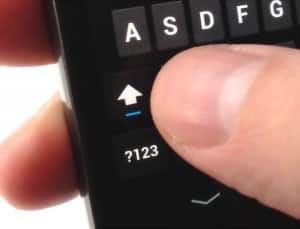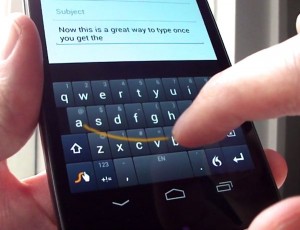
Ever dread the thought of tapping out a text or replying to email on your slippery Android touchscreen? I know the feeling.
Here’s a half-dozen ways to make life easier on your fingertips, from
long-pressing your way to the symbol keys to letting your voice do the
typing.
1. Long-press for accents, numbers, and symbols
Need an accent above a vowel, or just a quick number or two?
Try this: tap and hold a key to reveal a pop-up menu of additional options.
For example, if you tap and hold a letter key along the top row of
the keypad, you’ll get a shortcut for the number that shares space on
that particular key.
Meanwhile, you can long-press any vowel key—say, “e”—for acute (“é”)
and grave (“è”) accents, as well as umlauts (“ë”), circumflex (“ê”), and
more.
You can also try the same trick with symbol keys. Tap and hold the
dash key (“-”), for example, and you’ll find an em dash (“—”), while
long-pressing the dollar sign (“$”) reveals symbols for the euro, the
Japanese yen, and the British pound, among others.
Last but not least, tap and hold the period for a pop-up menu of many
common symbol keys, including parenthesis, the colon and semicolon, the
pound sign, and quotes.

Just double-click the shift key to switch to all-caps mode.
2. Double-click for caps lock
Want to type in ALL CAPS? Not a problem. Just double-tap the shift key.
When you do, a telltale blue indicator will light up, and all the letter keys will jump into upper-case mode.
Ready to return to lowercase? Tap the shift key once more.
3. Turn off auto-correct
As you type, most Android phones will display a row of alternate
spelling possibilities just above the keyboard; tap one, and it’ll
replace the word you’re typing (or mangling, as the case may be).
Many Android phones may also let you replace a word automatically by tapping the spacebar or a punctuation key
Android’s “auto-correction” feature comes in handy when you’re typing
in a hurry, but it can also leave you a little red-faced if you wind up
texting that (for example) you’re in a “can” rather than a “cab.”

You can turn off Android’s “auto-correct” feature in just a few taps.
Rather not risk any auto-correct embarrassments? Here’s how:
- Tap Settings, Language & Input, find the Keyboard & Input
Methods heading, then tap the Settings icon next to “Android keyboard.”
(Note: The exact settings may differ depending on the make and model of
your Android phone; I tested this tip on a Samsung Galaxy Nexus, running
on Android version 4.2.1.)
- Scroll down to the Text Correction heading, then tap “Auto-correction.”
- A pop-up menu will give you a series of auto-correct options, from
“Modest” to “Very aggressive.” The setting we’re looking for, though, is
“Off.” Go ahead and tap it. And don’t worry: you’ll still see a row of
word suggestions above the keyboard, even with auto-correct disabled.
4. Speak instead of type
Don’t have a free hand for tapping out a text message? Well, there’s always the power of speech.
In the bottom-left corner of most recent Android phones, you’ll find a key stamped with a microphone icon.
Tap it and start talking—and as you do, your phone will listen carefully and start transcribing your words on the screen.
The results may not be perfect, and you may have to resort to tapping to replace a word or two.
That said, Android’s “voice recognition” feature can be uncannily
accurate—and unlike the iPhone, Android will let you voice-type even
without a data connection.
(Having trouble with voice recognition when your phone doesn’t have a
signal? Tap Settings, Language & Input, Voice Search,
and—finally—”Download offline speech recognition.”)

Even
if you don’t have the latest version of Android on your phone, Swype
will let you do the “swipe-to-type” trick on your handset.
5. Swipe instead of type
Is tapping on your Android phone’s virtual keypad slowing you down?
Here’s a way to speed up your touchscreen words-per-minute: swiping
instead of typing.
“Gesture Typing,” a feature in the latest version of Android, lets
you swipe smoothly from one letter to the next, almost like you’re
drawing words rather than typing them.
For using an older Android phone, there’s always Swype, a
downloadable Android add-on that also lets you do the swipe-to-type
trick.
Read more…
6. Use custom keyboard shortcuts
Getting tired of typing out your street address over and over, or
wish you could type a phrase like “On my way!” in just a few taps?
Using the “Personal dictionary” feature on newer Android phones, you
can designate your own, custom keyboard shortcuts, good for anything
from common phrases to your job title.
For example, you can tap “omw” to insert the phrase “on my way” into a
text or email message, or type “addr” (or anything you want) to call up
your home address.
a post from heresthethingblog.com
6 essential Android typing tips
 Never
quite got the hang of tap, tap, tapping on a touchscreen keypad? If
you’re using an Android phone and you’re feeling a little daring,
there’s a clever—and surprisingly elegant—alternative: swiping.
Never
quite got the hang of tap, tap, tapping on a touchscreen keypad? If
you’re using an Android phone and you’re feeling a little daring,
there’s a clever—and surprisingly elegant—alternative: swiping.



